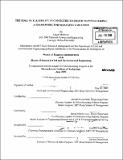| dc.contributor.advisor | Donald Rosenfield and David Simchi-Levi. | en_US |
| dc.contributor.author | Hoffman, Laurel (Laurel Anne) | en_US |
| dc.contributor.other | Leaders for Manufacturing Program. | en_US |
| dc.date.accessioned | 2010-03-25T14:54:30Z | |
| dc.date.available | 2010-03-25T14:54:30Z | |
| dc.date.copyright | 2009 | en_US |
| dc.date.issued | 2009 | en_US |
| dc.identifier.uri | http://hdl.handle.net/1721.1/53056 | |
| dc.description | Thesis (M.B.A.)--Massachusetts Institute of Technology, Sloan School of Management; and, (S.M.)--Massachusetts Institute of Technology, Dept. of Civil and Environmental Engineering; in conjunction with the Leaders for Manufacturing Program at MIT, 2009. | en_US |
| dc.description | Includes bibliographical references (p. 89-90). | en_US |
| dc.description.abstract | In this paper we examine a challenge that many companies are facing: how to respond to increased variation within their manufacturing operations. I posit that the challenges posed here are addressable with tools managers have within the four walls of their factory. Our goal is to better ensure that managers can keep their costs under control in times of turbulent change. Using Dell as an example of Configure-to-order (CTO) manufacturing at its extreme, and see how they are adapting their capabilities in order to become more flexible in this highly volatile marketplace. Variation is inevitable, and a key driver for companies to move to configure-to-order manufacturing. Variation can take on many forms, but in most cases variation degrades the performance of an optimized system. Depending on the source of the variation (either predictable or not) and the firm's ability to react to the variation, the tools with which we address this variation change. Put another way, in order to do customization well, a firm must be adept at using flexibility to its advantage. "How effectively firms can use the flexible technologies that do exist, create new, more responsive processes and management methods, and use the inherent flexibility of workers to more quickly develop and produce new products and services that more closely match individual tastes is the key to the new paradigm." (Pine, 1992) In order to be responsive to ever-changing customer demands, the modem firm must (1) understand the variation that confronts them and (2) have a strong grasp of how they provide value to their customers. | en_US |
| dc.description.abstract | (cont.) Using the framework outlined in this thesis, the practitioner should be able to identify the type of variation they wish to address, and the price they are willing to pay in order to achieve a flexible result. | en_US |
| dc.description.statementofresponsibility | by Laurel Hoffman. | en_US |
| dc.format.extent | 96 p. | en_US |
| dc.language.iso | eng | en_US |
| dc.publisher | Massachusetts Institute of Technology | en_US |
| dc.rights | M.I.T. theses are protected by
copyright. They may be viewed from this source for any purpose, but
reproduction or distribution in any format is prohibited without written
permission. See provided URL for inquiries about permission. | en_US |
| dc.rights.uri | http://dspace.mit.edu/handle/1721.1/7582 | en_US |
| dc.subject | Sloan School of Management. | en_US |
| dc.subject | Civil and Environmental Engineering. | en_US |
| dc.subject | Leaders for Manufacturing Program. | en_US |
| dc.title | The role of flexibility in Configure-to-order manufacturing : a framework for managing variation | en_US |
| dc.title.alternative | Role of flexibility in CTO manufacturing : a framework for managing variation | en_US |
| dc.type | Thesis | en_US |
| dc.description.degree | S.M. | en_US |
| dc.description.degree | M.B.A. | en_US |
| dc.contributor.department | Leaders for Manufacturing Program at MIT | en_US |
| dc.contributor.department | Massachusetts Institute of Technology. Department of Civil and Environmental Engineering | |
| dc.contributor.department | Sloan School of Management | |
| dc.identifier.oclc | 501190381 | en_US |
